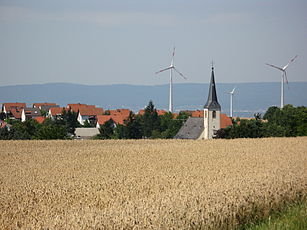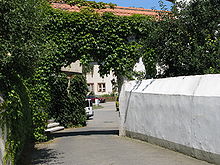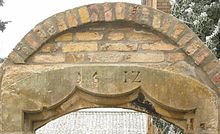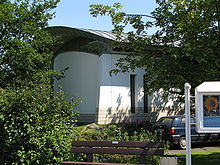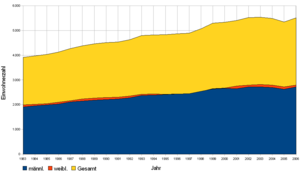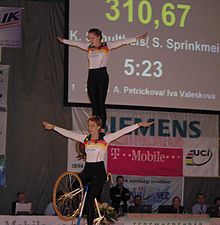Mainz-Ebersheim
|
Ebersheim district of Mainz |
|||||||||
|---|---|---|---|---|---|---|---|---|---|
| Coordinates | 49 ° 54 ′ 45 " N , 8 ° 14 ′ 45" E | ||||||||
| height | 245 m above sea level NN | ||||||||
| surface | 9.833 km² | ||||||||
| Residents | 5971 (Dec. 31, 2019) | ||||||||
| Population density | 607 inhabitants / km² | ||||||||
| Proportion of foreigners | 13.4% (Dec. 31, 2019) | ||||||||
| Incorporation | Jun 7, 1969 | ||||||||
| Community key | 07 3 15 000 | ||||||||
| Post Code | 55129 | ||||||||
| prefix | 06136 | ||||||||
Administration address |
Römerstrasse 17 55129 Mainz |
||||||||
| Website | www.mainz.de | ||||||||
| politics | |||||||||
| Head of town | Anette Odenweller ( CDU ) | ||||||||
| Allocation of seats (local advisory board) | |||||||||
|
|||||||||
| Transport links | |||||||||
| bus | Line 66 (Nieder-Olm - Hechtsheim - Mainz)
Line 67 (Zornheim - Hechtsheim - Mainz) also on Mondays-Fridays |
||||||||
Ebersheim is a district of the Rhineland-Palatinate state capital Mainz .
It is the most remote, highest and most viniculture district of Mainz and forms with its borders the southern branch of the city. Ebersheim is known as the gateway to Rheinhessen because of its location in Mainz .
Ebersheim was first mentioned in a document in 764 in a deed of donation from St. Alban 's Abbey to Lorsch Abbey .
Although Ebersheim has been part of the city of Mainz since 1969, it has a rural character. The townscape is mixed. On the one hand there are farms, wineries and old buildings in the center, on the other hand there are new development areas, terraced houses and a multi-family housing estate (with up to seven floors per house) on the outskirts. The Rhine-Hessian way of life can be felt in Ebersheim. For example, the cultural highlights are the wine festival in the village and the curb .
A special feature of Ebersheim is the area code, which differs from the Mainz area code 06131. With its dialing code 06136, Ebersheim belongs to the local network of the city of Nieder-Olm in the Mainz-Bingen district .
geography
Geographical location
Ebersheim is, like most of the Rheinhessen towns, in an agricultural landscape . The agricultural landscape is characterized by arable farming , fruit growing and viticulture . Ebersheim is located on the eastern slope of the Mühlberg (243 m NN) and on the northeast slope of the Muhl ( Auf der Muhl 245 m NN), the highest point in the city of Mainz. The lowest point of Ebersheim is at the eastern entrance to the town coming from the L 425 (193 m above sea level).
Neighboring districts and municipalities
The following municipalities or districts of Mainz border Ebersheim in a clockwise direction:
in the north Mainz-Hechtsheim , in the east Harxheim , in the south-east Mommenheim , in the south Zornheim , in the south-west Nieder-Olm , in the west Ober-Olm and in the north-west Klein-Winternheim .
geology
Ebersheim forms a plateau in the middle of the Mainz Basin , a sedimentation area that was created by the sinking of the Upper Rhine Rift. As a result, an inland sea penetrated , which led to the deposition of various marine sediments . A distinction is made between several phases of transgression ( rupelium ). The north-western sediments of the Ebersheim district partly date from this time. They are much more open-minded in the neighboring town of Nieder-Olm. In Ebersheim, the majority of this sediment is covered by later deposits, mainly Pleistocene loins that drifted aeolian during various ice and cold ages and were deposited here. Even more recently, loams from the Holocene were deposited east of Ebersheim in the Töngeswiese at the lowest point. They were probably created by the torrent, which originated at the time of the first settlement of the Auf der Muhl area and flowed into the Töngeswiese. On February 7, 1999, Ebersheim was the epicenter of a magnitude 2.5 earthquake (near Fort Muhl).
history
Early days
The oldest traces of human civilization in the Ebersheim district can be traced back to approx. 2200 BC. To date. It is a matter of the discovery of a bell beaker, a bell-shaped clay vessel, which dates from an end neolithic culture, the bell beaker culture , in the time of 2600 BC. Until about 2200 BC Was manufactured. The field name Langer Stein north of Ebersheim probably refers to a menhir , which dates from the Neolithic or the Bronze Age and can roughly be classified in the period of the bell-cup culture. Traces of the Bronze Age are also documented. A bronze knife and bronze lance tips were found in the Loh , a wood between Ebersheim and Nieder-Olm. The findings are the barrows -Periode and the Bronze urnfield- assigned. Later traces can only be found from the time after the Roman conquest.
Romans
Traces of Roman settlement exist in the form of remains of a villa rustica on the bank of a stream. This find and related small finds were dated to the 2nd to 4th centuries AD. Other individual finds are documented in the Ebersheim district, for example a vessel handle with silver inlays, a golden finger ring and a gladius .
Francs
An early Christian tombstone found in Ebersheim with the fragmentary inscription, which speaks of "[...] lindis" and "Velandu et Thudelindi", was found in Ebersheim from the Franconian period. It is believed that the name of a daughter and that of her parents are given here and that this daughter “lived in peace for 12 years”.
Between 400 AD and 500 AD a settlement was founded between the arms of the torrent in the area of today's Roman road.
middle Ages
Ebersheim was first mentioned in a document in 764 in a deed of donation from St. Alban 's Abbey to Lorsch Abbey . But here, too, there is a second possibility, a document from 789, which is described by a local historian as the earliest precisely datable document in which the name Aburinesheim is mentioned for Ebersheim. There is therefore no agreement on the naming or first documentary mention.
In 830, Ebersheim was named in a document as the "monastic property of the St. Maximin Abbey " near Trier. The certificate is not an initial award act. Accordingly, the change of ownership must have taken place earlier. In 1184 the Ebersheim church with chapel was first mentioned in a document. In the same year it was ordered that viticulture may only be carried out in the south of the place. It has remained that way to this day. In 1304 a village court was built at the intersection of Enggasse / Römerstraße / Neugasse, from which paths led to the surrounding villages. In 1324 members of the Antoniter Order founded the Anthonishof , today's Töngeshof as a country estate to supply their city branch , which at that time was still independent and did not belong to Ebersheim. From 1420 onwards, after several changes of ownership, Ebersheim belonged to the Kurstaat Mainz for the next 350 years and was under its protection. In the turmoil of the Reformation (after 1525) the rectory was burned down.
Modern times until 1945

In 1577, the Elector of Mainz, Daniel Brendel von Homburg , ordered maps to be made for Mainz. Thereupon Ebersheim was first mapped by Gottfried Mascop . You can see the parish church, the Anthonishof (Töngeshof) and the Ebersheimer doors - the Mainzer Gate in the north, the church door to the west and the sheep gate in the south - as well as the crest Ebersheimer containing the grate even then.
In 1612 the destroyed rectory was rebuilt, of which an arched curtain with the inscription "1612" still reminds us today. Around 1650, a mansion with the coat of arms of the Elector of Mainz Johann Philipp von Schönborn was built at the east end of the Töngeshof . In the plague year of 1666, around 100 Ebersheimers died. A school building was built on Römerstrasse in 1688. During the War of the Palatinate Succession (1688 to 1689), many Ebersheimers died from the consequences of the war and epidemics.
Between 1725 and 1729 the central nave of today's parish church with choir and sacristy was built. 17 years later the church was painted, two altars and the pulpit were built in, and images of the apostles were attached to the balustrade. In 1767 the group of figures of the Coronation of Mary was created. After the chapel, which contained the group of figures, was torn down and moved to a niche in the house, the Coronation of Mary is now restored in a chapel on Laurentiusstraße. In 1768 the church tower was built. 25 years later the church received the high altar from St. Quintin in Mainz. During the siege of fortress Mainz from 1794 to 1799, French soldiers were quartered in Ebersheim. Many Ebersheim residents fell victim to the epidemics they brought with them.
On December 30, 1797, Mainz and the areas on the left bank of the Rhine, including Ebersheim, became French and from then on belonged to the Département du Mont-Tonnerre . From 1807 Ebersheim had an independent Mairie (Mairie d'Eberheim Mont-Tonnerre) in the canton of Nieder-Olm .
The Duke of Dalberg sold the Töngeshof, which was no longer autonomous, to the Ebersheimers.
In 1813 and 1814, many Ebersheim residents died of typhus , which the French troops retreating from Leipzig dragged into Mainz and Ebersheim. Hunger and typhus also spread. The situation worsened with the subsequent three-month Russian-Prussian siege . Ebersheim bought the Albaniterhof from the monastery of St. Alban.
From 1816 Ebersheim belonged to the Mainz district . The city of Mainz had meanwhile been declared a federal fortress. As a result of the real division right, poverty increased in Ebersheim as in many municipalities in Rhine-Hesse. This triggered a wave of emigration to America between 1840 and 1880 . As a result of emigration, the situation of those left behind improved from 1850 onwards, and the wave of emigration subsided. In 1853 a synagogue was built for the 47-member Jewish community in Mainzer Strasse, today's Konrad-Adenauer-Strasse. On the site of the old rectory, a parsonage was built in the neo-baroque style in 1857 . The town hall and school house was built and occupied in Römerstraße . In 1859 the church was repainted. The German Confederation ended with the German War of 1866 and the Mainz fortress received a purely Prussian occupation.
To commemorate the Franco-Prussian War (1870–1871), a war memorial was erected with the inscription "God protect us on the day of battle" taken from Psalm 139. In 1887 the volunteer fire brigade was founded in Ebersheim, which already had its own syringe house. In 1895, the nurses' station of the Sisters of Divine Providence (Mainz) , connected with the child preservation institution , was completed. In 1897 the two streams that had flowed through Ebersheim for centuries disappeared due to structural measures. Mainz fortress was dissolved in 1904 so that the city could expand. The fortifications were located in front of Mainz, with Ebersheim becoming a strategic point in the new fortifications due to its geographical location. In 1905 a new school building was built on the parish grounds, which is now used by the local administration. Ebersheim got a water pipe with which the water shortage and the risk of typhus were eliminated. The fire brigade received a new, more modern building in 1908. The old syringe house was demolished. In the same year renovation work began on the Catholic Church. The choir and sacristy were rebuilt, the nave was lengthened, the aisles were added and portals were added. From 1908 to 1911, multi-storey fortifications and other fortifications were built on the Muhl . The Fort Muhl was the main work of Selzstellung , was located at the highest point of Ebersheim and was served by a funicular. Plans for the civil use of the fortress railway could not be implemented because of the First World War . In 1912 Ebersheim got electric light and the gymnastics club got its own sports field. During the First World War 100 Ebersheim residents were drafted. 40 of these citizens were reported dead or missing at the end of the war in 1918.
After the First World War was lost, Ebersheim was again under French occupation. In 1922 the fortifications and buildings were blown up and the fortress railway destroyed. The Ebersheim cycling club was founded.
Obergasse, which is now part of Laurentiusstrasse, was renamed Adolf-Hitler-Strasse in 1933. Käsgasse, today Dahlbergerstrasse, was henceforth called Hindenburgstrasse. The piece between the Effenspitze and Töngeshof was named Straße der SA . In 1935 Ebersheim was assigned to the Gau Hessen-Nassau. The wine cooperative was founded in 1936. In the same year the Joachimskreuz , which was destroyed during the Napoleonic Wars, was rebuilt. The synagogue in Ebersheim was burned down during the Reichspogromnacht in 1938. Many of the Jewish residents emigrated to the USA or moved to live with their relatives in Mainz, from where they were deported to Theresienstadt during the Second World War . Today a memorial plaque and the Jewish cemetery commemorate the Jewish community.
Large parts of Ebersheim burned down during the war. The fire brigade no longer had enough members, so a women's fire brigade was founded. The women's fire brigade was founded by Magret Becker (née Ginz). American tanks entered Ebersheim on March 20, 1945. The situation was considered dangerous by the Americans, and in fact an American soldier was killed in a bazooka attack in the days that followed. Ebersheim had 68 dead and missing in World War II .
Modern times from 1945
From 1945 to 1949 Ebersheim was under French occupation for the third time . Public life normalized and reconstruction began. All clubs had to be re-founded. Ebersheim received a new mayor, Balthasar Becker, and the Catholic kindergarten was reopened by the Sisters of Divine Providence . Ebersheim has belonged to the newly founded state of Rhineland-Palatinate since 1947 . In 1954 the nurses' station was closed. In 1957 the remains of the synagogue were bought from the Jewish community and demolished.
In 1961 the volunteer fire brigade received its first emergency vehicle with a TSF 8 portable fire pump . When a Lufthansa Boeing 720 crashed on December 4, 1961 in the Ebersheim area, all three crew members were killed. The Boeing 720-030B with the registration D-ABOK and the name "Düsseldorf" took off from Frankfurt Airport on a training flight shortly after noon . The cause of the accident could never be properly clarified.
In 1962 the Ebersheim riding and driving club was founded. Two years after the 2000th anniversary of the city of Mainz, Ebersheim celebrated its own 1500th anniversary in 1964. In the same year the Feldgarten elementary school was built and inaugurated. In 1966 the renovation of the church was completed.
On June 7, 1969, Ebersheim was incorporated into the city of Mainz with five other suburbs, with the majority approval of the residents . This ended the history of Ebersheim as an independent place. What is special is that Ebersheim, despite belonging to Mainz, still belongs to the Nieder-Olm local network with its phone code 06136. In the same year of incorporation, the community bus line 12 (later line 16 and from 2000 line 66) of the Ebersheim bus company Nauth and the Mainz transport company started operations. Two years later it became the property of the Mainzer Stadtwerke. In 1972 the volunteer fire brigade moved into a new fire station . The Ebersheim youth fire brigade was founded three years later . In 1980 the Ebersheimer Weinbrunnen was donated. In 1984 an independent Protestant community was founded in Ebersheim. The Töngeshalle was inaugurated in 1986 and the new Catholic kindergarten in 1995. In 1997 a new sports field was built. Single-family houses were built on the site of the old one. In 2003 a bus lane was built along Töngesstrasse.
Since December 2005, two city bus routes have been operating in Ebersheim for the first time. Line 66 was withdrawn as far as the Hechtsheimer Mühldreieck, where there is a connection to the tram, and from there it also operates as a night line. The new route 67 runs directly to the main train station during rush hour. Since December 2008, line 66 has been running Monday to Saturday during the day via Zornheim to the neighboring town of Nieder-Olm and four morning trips on line 67 to the Römisches Theater station. Since the timetable change in December 2019, line 66 has been running back to the city center of Mainz from Monday to Friday during rush hour.
Name development
The name Ebersheim probably originated in the time of the Frankish conquest around the 5th century AD. There are two theories about its origin. The first says that the name comes from a Frankish clan elder , Eberolf (Eberolfesheim), the second that the name is derived from the noble Franconian Abruwin or Eberwin (Aburinesheim). The place name developed over the centuries as follows:
- Ebirisheim (780)
- Evernesheim (893)
- Ebernesheim (1026)
- Ebernsheim (1092)
- Ebrensheim (1184)
- Ebirnsheim (1263)
- Ebberinsheim (1282)
- Ebirnsheim (1303)
- Ebursheim (1341)
- Ebersheim (1404)
Population development
Currently (as of December 31, 2019) 5971 residents have their main residence in Mainz-Ebersheim. The total number of inhabitants is 6053. The following shows the population development of Ebersheim according to the total number of inhabitants and by gender from 1983 to 2006.
|
|
politics
Local advisory board
Since the local council elections in 2019, the following parties have been represented in the local council:
Mayor and Mayor
The incumbent mayor is Anette Odenweller (CDU). She prevailed in a runoff election against the previous incumbent Matthias Gill of the Greens.
Until it was incorporated into the city of Mainz (1969), the town was headed by a mayor. After 1969, mayors were elected. Listed below are the mayors and mayors of Ebersheim and the respective inaugural year.
- Balthasar Becker (1945)
- Johann Babt. Eckert (1956)
- Johann Ambros Becker (1964, mayor from 1969)
- Klaus Nauth (1986)
- Friedrich Herberich (1992)
- Rainer Emrich (1994)
- Helgi Schwedass (2009)
- Matthias Gill (2014)
- Anette Odenweller (2019)
State politics
Mainz-Ebersheim belongs to the Mainz II constituency at the state level . In the state elections in 2016 , Doris Ahnen (SPD) won the direct mandate here. From 2021 the district will belong to the newly formed Mainz III constituency.
coat of arms
| Blazon : "A silver grate in red." | |
| Justification for the coat of arms: The coat of arms is derived from the patronage of the Catholic parish, which St. Lawrence of Rome holds and whose martyrdom is said to have taken place on a grate. The colors express the affiliation to the city of Mainz. The fire grate was used as a place seal as early as 1575. |
Religions
The religious affiliation statistics - Area 62 Ebersheim from the Office for Urban Development, Statistics and Elections (reference date February 3, 2010) shows the following distribution of religious affiliation in Ebersheim.
| Religions | Total affiliation |
Affiliation total (%) |
|---|---|---|
| Roman Catholic | 2,571 | 47.06 |
| none or no public law Rel.-Gem. | 1,238 | 22.66 |
| evangelical | 1,145 | 20.96 |
| other public law Rel.-Gem. | 340 | 6.22 |
| without disclosures | 140 | 2.56 |
| Israelite | 15th | 0.27 |
| without specification | 8th | 0.15 |
| Free religious community Mainz | 4th | 0.07 |
| Free state community | 1 | 0.02 |
| Old Catholic | 1 | 0.02 |
Culture and sights
Buildings
- The Catholic St. Laurentius Church was first mentioned in a bull by Pope Lucius III in 1184 . mentioned to the monastery of St. Alban.
- To commemorate the campaign in 1870/71, a war memorial was erected in front of the church with the inscription: “God protect us on the day of battle” ( Psalm 139).
- The wine fountain on the corner of Töngesstrasse and Neugasse, built in 1980.
- The Töngeshof, a former monk's farm from the Middle Ages, which is still surrounded by historic walls today.
- The Catholic rectory of the parish of St. Laurentius.
Regular events
- Wine hike Ebersheim
- Wine festival in the village , annually on the second weekend in July.
- Curb, annually on the second weekend in September.
Associations and groups
Because Ebersheim is the third smallest district of Mainz and is far from the city center, there are many clubs. The place has a lively club life that ranges from music to cycling and equestrian sports to carnival. Club life in Ebersheim has a long tradition, some of the clubs are over 100 years old.
The singers' association 1862/63 Ebersheim emerged in 1949 from the two traditional Ebersheim choral societies, Liederkranz - Die Gelben (1863) and Concordia - Die Schwarzen (1864), which had been competing strongly since they were founded, and was the oldest Ebersheim association until the end of its activity. The two associations had a great political influence in the village and were instrumental in mayoral elections and other important decisions. Individually and later together, they had a significant impact on life in Ebersheim for more than 100 years. Before the war, for example, they alternated between the carnival pageant and the Rose Monday parade in the village, as well as the Easter celebrations. There are also several other music associations, so the two parishes each have their own choirs.
The oldest active club is the gymnastics and sports club 1897 Mainz-Ebersheim . The club was originally founded as a gymnastics club with the help of Hechtsheimer Turner, but merged in 1925 with the soccer club DJK Cäcillia Ebersheim to form the gymnastics and sports club, which is now divided into the five branches of gymnastics, soccer, basketball, table tennis and athletics. Another well-known sports club is the 1925 Mainz-Ebersheim eV cycling club , to which the six-time world champions in artistic cycling Katrin Schultheis and Sandra Sprinkmeier belong.
The Ebersheimer Carneval - Verein eV - Die Römer is Ebersheim's first carnival club. It was founded in 1987. The reason for the late foundation is the fact that the local clubs used to organize the foolish hustle and bustle in Ebersheim and only when they could no longer take on the task did the need for their own carnival club become clear. Today the association has an annual campaign which includes two ceremonial meetings. Since 2003 the association has had its own ballet, the ECV-Ballet Las Romanas . The ballet is active all year round and takes part in tournaments as well as in various dance events and parades.
There is also a trade association and several development associations in Mainz-Ebersheim.
Economy and Infrastructure
Viticulture
Viticulture in Ebersheim has a long tradition. The Ebersheim vineyards were already mentioned in 773 in the Lorsch Abbey donation book. The Ebersheim wine tradition is almost as old as the Rheinhessen one , which was first mentioned in a document in 753. Even then it became clear that Ebersheim would have a good wine year in 10 years. Under the supervision of the St. Alban Monastery , it was ordered in 1184 that, for quality assurance purposes, wine could only be grown on the south side of Ebersheim, and it has remained so to this day. Despite the arrangement, in 1798 the usable area that was dedicated to viticulture was quite high at over a tenth. Today wine is produced of high quality. The wine festival in the village is a magnet for visitors; see also viticulture in Mainz . In 2003, 104 degrees Oechsle were measured in Ebersheim .
- Locations
The Ebersheim vineyards belong to the St. Alban area and are divided into three individual layers. The Hüttberg , the sand and the wine cellar .
The soil of the Hüttberg is loamy clay. The site has an area of 21 hectares, is inclined and oriented to the south-southwest. Gewürztraminer , Riesling and Scheurebe , for example , are grown here. The sand is 50 hectares, the largest area of wine growing situation in Ebersheim. Its soil is made of clay, the slope is also sloping and the orientation is south-southeast. Silvaner , for example, is grown here. In the wine cellar, loamy clay can be found again as the floor. As with sand, its orientation is south-southeast, the slope is also dependent here and the area is 35 hectares. Pinot Noir is grown here, for example .
- Historical valuations
- Wine quality 1627: "sour wine"
- Wine quality 1638: "very good and expensive"
- Wine quality 1639: "sour crab apple broth"
- Wine quality 1688 - 1689: "good, consumed by the war"
- Wine quality 1747: "particularly good but not much"
- Wine quality 1751: "bad, hardly drinkable"
- Wine quality 1809: "sour 1/16 autumn"
- Wine quality 1862–1863: "in the strength of the 61er below, but sweeter and more pleasant for gourmets, about 1/16 autumn"
- Wine quality 1906: "Yield = 0, downy mildew occurred very strongly"
- Wine quality 1911: "Wine of the century"
- Wine quality 1921: "Noble plant, trumps the quality of the 1911, parish 138 °"
- Wine Queen
Ebersheim is the residence of the Rheinhessen wine queen 2003/2004 Eva Vollmer . She was elected on October 6, 2003 with five other wine majesties and was a representative of Rheinhessen wine for the following two years. In addition, Karin Eckert from Ebersheim became the Rhine-Hessian wine princess in 2010/2011 alongside Annika Strebel, who was born in Germany and later became the German wine queen.
Education and child care
Ebersheim has a primary school, the primary school "Im Feldgarten". This is a branch of the Volkshochschule Mainz. In addition, a seminar will be held in the local administration.
There are four preschool childcare facilities in Ebersheim:
- Parents' initiative Kleine Trolche
- Catholic day care center St. Laurentius
- Ebersheim day care center
- the two municipal kindergartens Die Feldmäuse and Wolkenburg
Municipal institutions
- Ebersheim youth center
The Ebersheim youth center is located at Feldgartenstrasse 1, right next to the primary school. It is together with the Hechtsheim youth center, the Hechtsheim / Ebersheim children's, youth and cultural center .
- Local administration Ebersheim
The local administration of Ebersheim is located directly below the church. Various actions in the field of registration and passport systems can be carried out here.
Personalities
Sons and daughters of the district
- David Nikolaus Becker (1932–2016), Domprabendat and external judge in the Episcopal Office of Mainz.
- Eva Vollmer, Rheinhessische Weinkönigin 2003/2004.
- Katrin Schultheis and Sandra Sprinkmeier , world record holders, world champions in artificial cycling 2007 to 2009 and 2011, vice world champions 2004–2006 and 2010, German champions 2006, 2009, UCI ranking winners 2004, 2005, 2007, 2008 and 2009.
- Karin Eckert, Rheinhessische Weinprinzessin 2010/11
- Rebecca Matzon, gymnast
Personalities who have worked on site
- Hermann Reifenberg (* 1928), Catholic theologian and liturgical scholar, 1961–1965 pastor in Ebersheim
See also
literature
- Claus Wolff: The districts of Mainz . Verlag Philipp von Zabern , Mainz 2007, ISBN 3-89705-361-6 .
- Ronald Knöchlein: Ebersheim. From the earliest settlement to the Franconian period (Archaeological Site Considerations, 10) . Emons Verlag, Cologne 2004, ISBN 978-3-935970-04-4 .
- Festival book committee of the community of Ebersheim: 1500 years Ebersheim. Festschrift for the anniversary celebration of the community of Ebersheim near Mainz in 1964 . Wilhelm Traumüller, Oppenheim am Rhein 1964 ( ebersheimer-geschichte.de ).
- Helmut Schwalbach, Jakob Blumers, Gabriele Werner: 800 years of the church in the village 1184 - 1984 . 1984 ( ebersheimer-geschichte.de ).
- Friedrich Eckert: Mainz-Ebersheim Volume (1-4) . 1984 ( ebersheimer-geschichte.de ).
- Helmut Schwalbach: St. Laurentius Mainz-Ebersheim, a companion through the church . ( ebersheimer-geschichte.de ).
- Jacob Becker : The oldest traces of Christianity on the Middle Rhine. In: Annals of the Association for Nassau antiquity and historical research . 1864. (Pages 18-21. The article was erroneously assigned to Ibersheim near Worms instead of Ebersheim near Mainz)
Web links
- Information from the city of Mainz on the Ebersheim district
- Ebersheim album - home history and home pictures
- Historical information about Ebersheim at regionalgeschichte.net
Individual evidence
- ↑ a b State Office for Geology and Mining Rhineland-Palatinate
- ^ Rudolf Büllesbach: Heimatgeschichte: The riddle about the crash of the "Düsseldorf". (PDF, 167 kB) Retrieved April 8, 2018 (Ebersheimer Schaufenster).
- ^ Allgemeine Zeitung: Voluntary fire brigade celebrates its 125th birthday , August 3, 2006
- ↑ Official municipality directory 2006 ( Memento from December 22, 2017 in the Internet Archive ) (= State Statistical Office Rhineland-Palatinate [Hrsg.]: Statistical volumes . Volume 393 ). Bad Ems March 2006, p. 186 (PDF; 2.6 MB). Info: An up-to-date directory ( 2016 ) is available, but in the section "Territorial changes - Territorial administrative reform" it does not give any population figures.
- ↑ Residents in Mainz by district on December 31, 2019 - mainz.de (PDF)
- ↑ www.mainz.de - Eligible population by nationality, gender and districts
- ↑ Anette Odenweller is the new head of Ebersheim
- ↑ Members by constituency , website of the Rhineland-Palatinate state parliament
- ^ The Regional Returning Officer of Rhineland-Palatinate : The election to the 18th State Parliament of Rhineland-Palatinate in 2021 (PDF; description of the Mainz constituencies on page 9)
- ^ Successes of the Mainz-Ebersheim cycling club
- ↑ www.wein-wg.de - winegrowers directory
- ↑ Source: Successes - Website from Schultheis and Sprinkmeier
- ↑ Mainz double victory at the Artistic Cycling World Championships in Portugal in the Allgemeine Zeitung Mainz on November 8, 2009
- ↑ Matzon's almost perfect year
- ↑ From Bodenheim to Tokyo?


